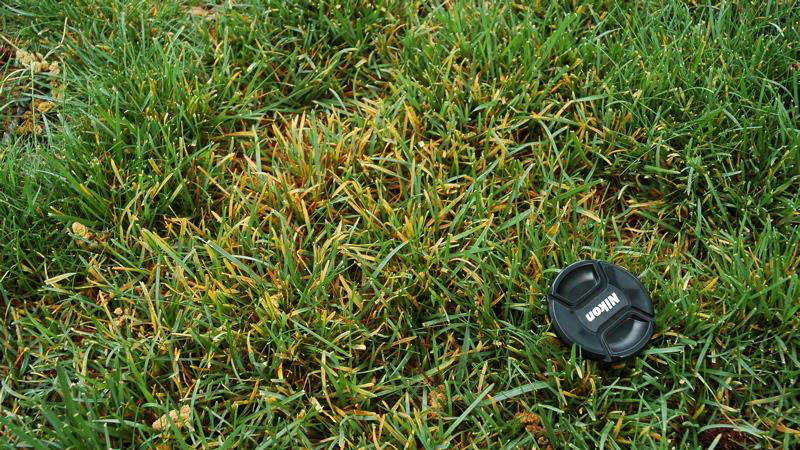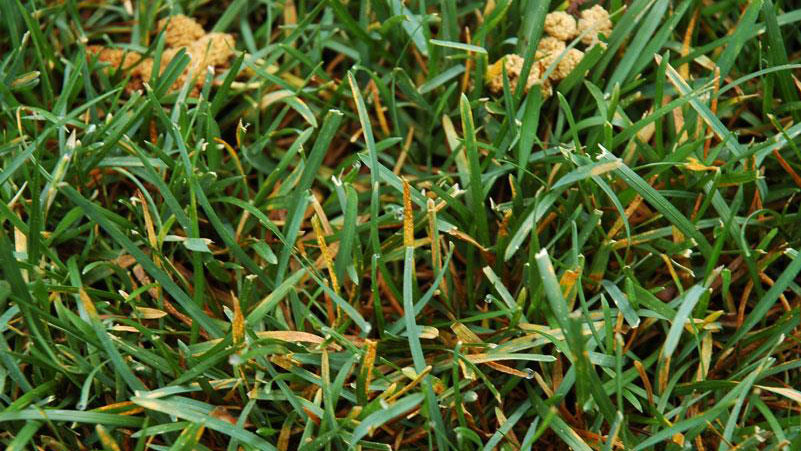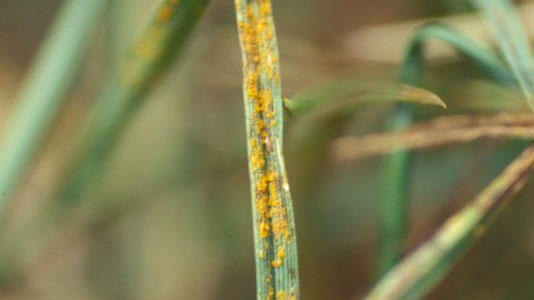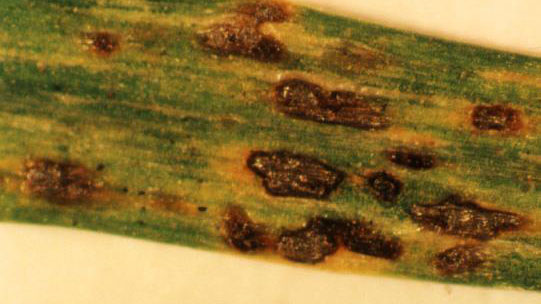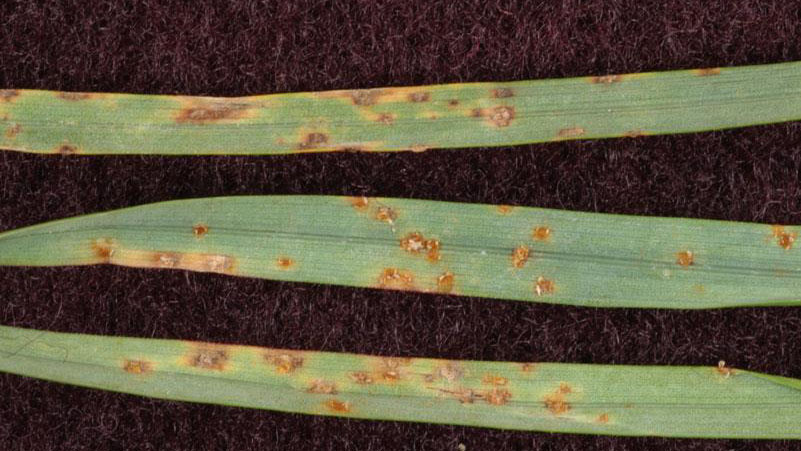Symptoms
Early symptoms include small, yellow flecks that develop on the leaves and stems. The flecks expand over time into raised pustules, yellow or orange in color, that rupture to release powdery masses of spores. Infected plants become yellow and are more susceptible to environmental stress. Heavily infected areas become thin and exhibit clouds of orange dust (rust spores) when the foliage is disturbed. The rust pustules on infected leaves turn black during the fall in preparation for overwintering.
Development Factors
Rust fungi survive the winter in living plant tissue from which new spores are produced in the spring. Spores produced in the spring, summer, and fall are spread by the wind, germinate on the leaves, and infect new tissue. Extended periods of leaf wetness are required for the spores to germinate and for the disease to develop rapidly.
Rust diseases are most severe in turf that is growing slowly due to adverse weather conditions or inadequate management. Low light intensity, inadequate fertilization, drought stress, and infrequent mowing encourage rust development.
Cultural Control
Plant rust-resistant turfgrass varieties whenever possible to reduce injury from this disease. Select cultivars based on regional trials and university recommendations. When planting cool-season turfs, use blends and mixtures of multiple species and/or varieties whenever possible. Plant shade tolerant grasses and raise mowing heights in heavily shaded areas.
Prune trees and remove unwanted undergrowth to improve air movement and reduce prolonged leaf wetness. Mow the turf on a regular basis, removing no more than 1/3 of the foliage in one mowing. Collect and dispose of clippings taken from infected areas to slow the spread of rust.
Fertilize to meet the nutritional needs of the turf. Submit a soil sample for analysis on a regular basis and apply recommended amounts of phosphorus, potassium, and lime. Apply nitrogen based on university recommendations.
Water deeply but infrequently to encourage deep rooting and reduce drought stress and extended periods of leaf wetness. Avoid watering the turf before sunset or after sunrise.
Chemical Control
Fungicides can be used on a preventative or curative basis for rust control. Susceptible turfs should be monitored regularly for rust development during periods of cool and cloudy weather.
* Products marked with an asterisk are not labeled for home lawn use.
| Fungicide and Formulation1 | Amount of Formulation2 | Application Interval (Days)3 | Efficacy Rating | Resistance Risk | FRAC Code4 |
| azoxystrobin (Heritage) WG TL G |
0.2 to 0.4 1 to 2 2 to 4 lbs |
14 to 28 14 to 28 14 to 28 |
++++ | High | 11 |
| azoxystrobin + acibenzolar-S-methyl (Heritage Action)* | 0.2 to 0.4 | 14 to 28 | ++++ | High | 11/P01 |
| azoxystrobin + chlorothalonil (Renown)* | 2.5 to 4.5 | 14 to 21 | ++++ | High | 11/M5 |
| azoxystrobin + difenoconazole (Briskway)* | 0.5 to 1.2 | 14 to 28 | ++++ | High | 11/3 |
| azoxystrobin + propiconazole (Headway) EC G |
1.5 to 3 2 to 4 lbs |
14 to 28 14 to 28 |
++++ | High | 11/3 |
| azoxystrobin + propiconazole (Compendium) | 1.3 to 2.6 | 14 to 18 | ++++ | High | 11/3 |
| azoxystrobin + tebuconazole (Strobe T)* | 0.75 to 1.5 | 14 to 21 | ++++ | High | 11/3 |
|
benzovindiflupyr + difenoconazole (Ascernity)* |
1.0 | 14 to 21 | ? | ? | 7/3 |
|
boscalid + chlorothalonil (Encartis)* |
4 | 14 | +++ | Medium | 7/M5 |
| chlorothalonil (Daconil Ultrex)* |
3.7 to 5 |
14 | +++ | Low | M5 |
| chlorothalonil (Daconil Weather Stik)* | 4 to 5.5 | 14 | +++ | Low | M5 |
| chlorothalonil (Daconil Zn)* | 6 to 8 | 14 | +++ | Low | M5 |
| chlorothalonil + acibenzolar-S-methyl (Daconil Action) * | 4 to 5.4 | 14 | +++ | Low | M5/P01 |
| chlorothalonil + fluoxastrobin (Fame C)* | 3 to 5.9 | 14 to 28 | ++++ | Medium | M5/11 |
| chlorothalonil + propiconazole (Concert II)* | 4.5 to 8.3 | 14 to 28 | ++++ | Medium | M5/3 |
| chlorothalonil + propiconazole + fludioxonil (Instrata)* | 2.75 to 6 | 14 to 28 | ++++ | Medium | M5/3/12 |
| chlorothalonil + thiophanate-methyl (Spectro)* | 3.72 to 5.76 | 7 to 14 | +++ | Medium | M5/1 |
|
cyazofamid + azoxystrobin (Union) |
2.9 to 5.75 | 14 to 28 | ++++ | High | 21/11 |
|
fluindapyr + flutriafol (Kalida) |
0.25 to 0.4 | 14 to 21 | +++ | Medium | 7/3 |
| fluoxastrobin (Fame) | 0.18 to 0.36 | 14 to 28 | ++++ | High | 11 |
| flutriafol (Rayora)* | 0.7 to 1.4 | 14 to 21 | ++++ | Medium | 3 |
| mancozeb (Fore)* (Dithane)* |
4 4 |
|
++ | Low | M3 |
| metconazole (Tourney) | 0.37 | 14 | ++++ | Medium | 3 |
| myclobutanil (Eagle) | 1.2 | 14 to 28 | ++++ | Medium | 3 |
| propiconazole (Banner MAXX II) | 1 to 2 | 14 to 28 | ++++ | Medium | 3 |
|
pydiflumetofen + azoxystrobin + propiconazole (Posterity XT)* |
1.5 to 3 | 14 to 28 | ++++ | High | 7/11/3 |
| pyraclostrobin (Insignia) WG SC |
0.5 to 0.9 0.4 to 0.7 |
14 to 28 14 to 28 |
++++ | High | 11 |
| pyraclostrobin + boscalid (Honor)* | 0.55 to 1.1 | 14 to 28 | ++++ | High | 11/7 |
| pyraclostrobin + fluxapyroxad (Lexicon Intrinsic) | 0.34 to 0.47 | 14 to 28 | ++++ | High | 11/7 |
| tebuconazole (Torque)* (Mirage)* |
0.6 to 1.1 1 to 2 |
21 14 to 28 |
++++ | Medium | 3 |
| triadimefon (Bayleton) | 0.5 to 1 | 15 to 30 | ++++ | Medium | 3 |
| trifloxystrobin (Compass) | 0.1 to 0.15 0.2 to 0.25 |
14 21 |
++ | High | 11 |
| trifloxystrobin + triadimefon (Armada) (Tartan)* |
0.6 to 1.5 1 to 2 |
14 to 28 14 to 28 |
++++ | High | 11/3 |
| triticonazole (Trinity) (Triton) |
0.5 to 1 0.28 to 0.55 |
14 to 28 14 to 28 |
++++ | Medium | 3 |
| triticonazole + chlorothalonil (Reserve)* | 3.2 to 4.5 | 14 to 28 | ++++ | Medium | 3/M5 |
| 1 Other trade names with the same active ingredients are labeled for use on turfgrasses and can be used according to label directions. 2 Units are oz, fl oz, or lb depending on formulation. Apply fungicides in 2 to 5 gallons of water per 1,000 square feet according to label directions. Use lower rates for preventive and higher rates for curative applications. 3 Use shorter intervals when conditions are very favorable for disease. 4 Fungicide Resistance Action Committee code. Products with same code have the same mode of action and are in the same chemical class. * Products marked with an asterisk are not labeled for home lawn use. |
|||||
| Efficacy Rating ++++ = excellent control when conditions are highly favorable for disease development +++ = good control when disease pressure is high, excellent control when disease pressure is moderate ++ = good control when disease pressure is moderate, excellent control when disease pressure is low + = good control when disease pressure is low ? = not rated due to insufficient data |
|||||
| Resistance Risk Low = Rotate to different chemical class after 3-4 applications; tank mixing not necessary Medium = Rotate to different chemical class after 1-2 applications; tank-mixing with low or medium risk product recommended High = Rotate to different chemical class after EVERY application; tank-mix with low or medium risk product for EVERY application ? = not rated due to insufficient data |
|||||
Species Data
- HOST SPECIES
- MONTHS WITH SYMPTOMS
- March to June, September to November
- STAND SYMPTOMS
- FOLIAR SYMPTOMS LOCATION / SHAPE
- dieback from leaf tip, blighting of entire leaves, or no distinct leaf symptoms
- FOLIAR SYMPTOMS COLOR
- ROOT / CROWN SYMPTOMS
- none
- FUNGAL SIGNS
- blisters on leaves
Publication date: Nov. 10, 2017
Reviewed/Revised: Dec. 16, 2019
Recommendations for the use of agricultural chemicals are included in this publication as a convenience to the reader. The use of brand names and any mention or listing of commercial products or services in this publication does not imply endorsement by NC State University or N.C. A&T State University nor discrimination against similar products or services not mentioned. Individuals who use agricultural chemicals are responsible for ensuring that the intended use complies with current regulations and conforms to the product label. Be sure to obtain current information about usage regulations and examine a current product label before applying any chemical. For assistance, contact your local N.C. Cooperative Extension county center.
N.C. Cooperative Extension prohibits discrimination and harassment regardless of age, color, disability, family and marital status, gender identity, national origin, political beliefs, race, religion, sex (including pregnancy), sexual orientation and veteran status.

